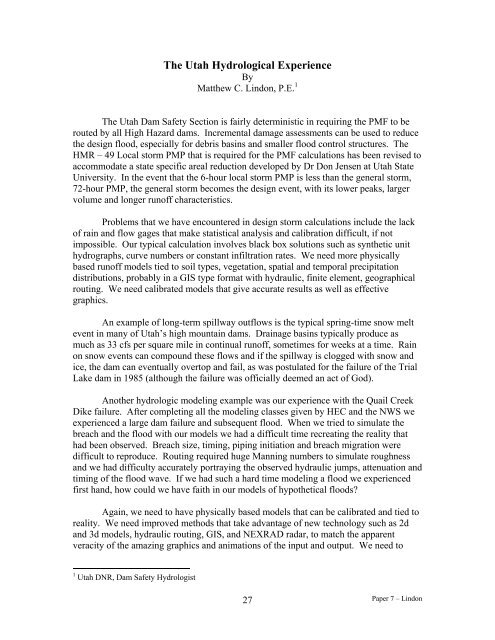Hydrologic Issues for Dams - Association of State Dam Safety Officials
Hydrologic Issues for Dams - Association of State Dam Safety Officials
Hydrologic Issues for Dams - Association of State Dam Safety Officials
You also want an ePaper? Increase the reach of your titles
YUMPU automatically turns print PDFs into web optimized ePapers that Google loves.
The Utah <strong>Hydrologic</strong>al ExperienceByMatthew C. Lindon, P.E. 1The Utah <strong>Dam</strong> <strong>Safety</strong> Section is fairly deterministic in requiring the PMF to berouted by all High Hazard dams. Incremental damage assessments can be used to reducethe design flood, especially <strong>for</strong> debris basins and smaller flood control structures. TheHMR – 49 Local storm PMP that is required <strong>for</strong> the PMF calculations has been revised toaccommodate a state specific areal reduction developed by Dr Don Jensen at Utah <strong>State</strong>University. In the event that the 6-hour local storm PMP is less than the general storm,72-hour PMP, the general storm becomes the design event, with its lower peaks, largervolume and longer run<strong>of</strong>f characteristics.Problems that we have encountered in design storm calculations include the lack<strong>of</strong> rain and flow gages that make statistical analysis and calibration difficult, if notimpossible. Our typical calculation involves black box solutions such as synthetic unithydrographs, curve numbers or constant infiltration rates. We need more physicallybased run<strong>of</strong>f models tied to soil types, vegetation, spatial and temporal precipitationdistributions, probably in a GIS type <strong>for</strong>mat with hydraulic, finite element, geographicalrouting. We need calibrated models that give accurate results as well as effectivegraphics.An example <strong>of</strong> long-term spillway outflows is the typical spring-time snow meltevent in many <strong>of</strong> Utah’s high mountain dams. Drainage basins typically produce asmuch as 33 cfs per square mile in continual run<strong>of</strong>f, sometimes <strong>for</strong> weeks at a time. Rainon snow events can compound these flows and if the spillway is clogged with snow andice, the dam can eventually overtop and fail, as was postulated <strong>for</strong> the failure <strong>of</strong> the TrialLake dam in 1985 (although the failure was <strong>of</strong>ficially deemed an act <strong>of</strong> God).Another hydrologic modeling example was our experience with the Quail CreekDike failure. After completing all the modeling classes given by HEC and the NWS weexperienced a large dam failure and subsequent flood. When we tried to simulate thebreach and the flood with our models we had a difficult time recreating the reality thathad been observed. Breach size, timing, piping initiation and breach migration weredifficult to reproduce. Routing required huge Manning numbers to simulate roughnessand we had difficulty accurately portraying the observed hydraulic jumps, attenuation andtiming <strong>of</strong> the flood wave. If we had such a hard time modeling a flood we experiencedfirst hand, how could we have faith in our models <strong>of</strong> hypothetical floods?Again, we need to have physically based models that can be calibrated and tied toreality. We need improved methods that take advantage <strong>of</strong> new technology such as 2dand 3d models, hydraulic routing, GIS, and NEXRAD radar, to match the apparentveracity <strong>of</strong> the amazing graphics and animations <strong>of</strong> the input and output. We need to1 Utah DNR, <strong>Dam</strong> <strong>Safety</strong> Hydrologist27Paper 7 – Lindon

















